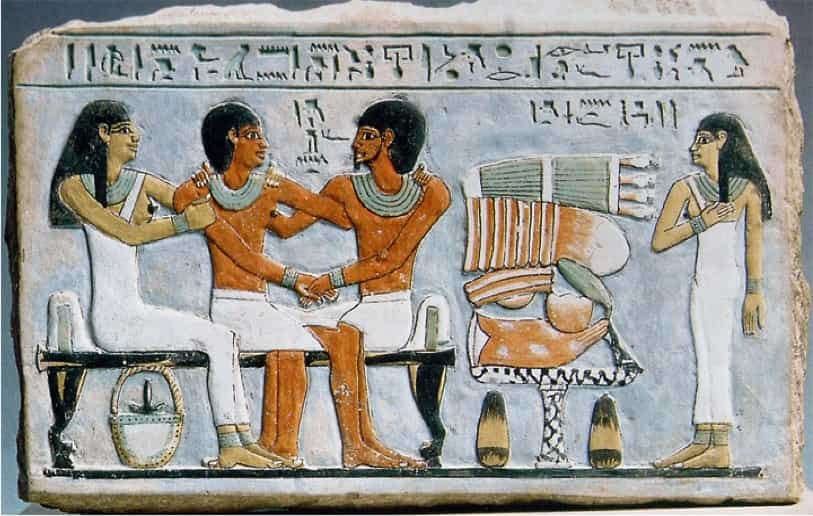Φαντάζομαι ότι όλοι γνωρίζετε τι σημαίνει ‘Χημεία’ και τι αυτή αφορά. Άλλωστε, λίγο πολύ όλοι θα έχετε κάνει το αντίστοιχο μάθημα στο σχολείο, αν όχι και παραπέρα.
Από που, λοιπόν, προέρχεται το όνομα της επιστήμης αυτής και πως αναλύεται; Εδώ υπάρχει μια μεγάλη εκπληξη!
Η λέξη ‘Χημεία,’ λοιπόν, προέρχεται και έχει τις βαθιές της ρίζες στο αρχαίο αιγυπτιακό ‘km.t’ που αποδίδεται κοινώς ως ‘κέμ-ετ’ και σήμαινε ‘μαύρη γη’ σε σχέση με το χώμα που αποτίθονταν και κάλυπτε τις πλημμυρικές ζώνες του ποταμού Νείλου κατά την εποχή των ετήσιων πλημμύρων του(1).
Το χώμα αυτό ήταν εξαιρετικά πλούσιο σε στοιχεία που έκανε τις ‘μαύρες’ αυτές ζώνες πολύ εύφορες και συνεπώς θα έδινε την εντύπωση κάποιου είδους ‘μαγείας’ ιδιαίτερα ευπρόσδεκτης για τους αρχαίους Αιγύπτιους ενώ το όνομα επεκτάθηκε για να χαρακτηρίζει τελικά ακόμη και την ίδια τους τη χώρα ως ‘Κέμ-ετ’ (‘Χώρα της Μαύρης Γης’).
Η πρώτη παρουσία της λέξης km.t φαίνεται να γίνεται τόσο παλιά όσο περίπου το 3100 π.Χ. και την Πρώιμη Δυναστική Περίοδο ενώ ως όνομα για την ίδια την χώρα δείχνει να εμφανίζεται κατά την βασιλεία του Mentuhotep II (2060-2009 π..Χ.) της ΧΙ Δυναστείας και μετάβαση από την Πρώτη Ενδιάμεση Περίοδο στο Μέσο Βασίλειο.
Μάλιστα, από ό,τι καταλαβαίνω, το όνομα ακόμη χρησιμοποιείται για την Αίγυπτο σε περιοχές της Μέσης Ανατολής και που αναλύεται σε ‘km’ (κεμ-), που σημαίνει ‘μαύρο/μαυρίλα,’ και το επίθεμα ‘.t’ (-ετ) που δίνει την έννοια της χώρας/περιοχής στο πρώτο, σε μια δομή που δείχνει σημιτική.
Από την άλλη πλευρά, φαίνεται να υπάρχει μια σύγχυση σε ό,τι αφορά την λέξη ‘χημεία,’ με αρκετά ‘δάνεια’ και ‘αντιδάνεια’ μεταξύ γλωσσών και περιοχών μέσα στους αιώνες, για το ποια ακριβώς ήταν η πορεία της διαμόρφωσής της και πότε πρωτοεμφανίστηκε.
Έτσι, σε άλλες πηγές φαίνεται να πρωτοεμφανίζεται στον 4ο αιώνα μ.Χ. σε μια πραγματεία του Ρωμαίου αστρολόγου και συγγραφέα Julius Firmicus Maternus ως ‘chemyia’ ενώ σε άλλες (αλλά λιγότερες) ότι εμφανίστηκε αρχικά γύρω στα τέλη του 4ου αιώνα π.Χ. ως ‘χυμεία’ στην Κοινή από το πρωτύτερο αρχαιο-ελληνικό ‘χύμα,’ με το τελευταίο ως συμφυρμό του ‘Χημία’ (Αίγυπτος) και ‘χημία’ (μαύρη γη).
Ωστόσο, η δεύτερη εκτίμηση δεν δείχνει ιδιαίτερα ‘στέρεη’ για κάποιους σημαντικούς λόγους όπως:
α) η κατάληξη ‘-ία’ στην περίπτωση του ‘Χημία’ (Αίγυπτος, η χώρα) θα ήταν ‘-εία΄ (γη, χώρα) ως προς τη μορφή ‘Χημεία’ και προφορά ‘Κεμέα’ ενώ στο ‘χημία’ (μαύρη γη) η προφορά θα ήταν ‘κέμια’ αντιθέτως (και έτσι θα διακρίνονταν και μεταξύ τους).
β) Το ‘χύμα,’ στα αρχαία ελληνικά προφερόμενο ως ‘κούμα,’ προερχόταν από το προ-ελληνικό ‘k(h)uma’ (δασυνόμενο ‘κ’) που είναι πιθανώς Λούβιο.
γ) To km.t (κέμ-ετ) φαίνεται ότι πολύ παλαιότερα προφερόταν ως ‘κούμ-ατ’ που υποδεικνύει την αντίστοιχη εξέλιξη του πρώτου συνθετικού από ‘χυμ-‘ σε ‘χημ-‘ (προφερόμενα ως ‘κουμ-‘ και ‘κεμ-‘ αντίστοιχα) και όχι το αντίθετο (βλέπε επίσης β παραπάνω).
Θα πρέπει να πούμε ότι φαίνεται ότι υπήρχε αιγυπτιακή λέξη ‘khēmia’ (‘κέμια’)(2) που σήμαινε ‘μετατροπή της γης,’ δεδομένου μάλιστα ότι ο Ρωμαίος αυτοκράτορας Diocletian αναφέρεται σε αυτή, που δείχνει ότι η καταγωγή της λέξης ‘Χημεία’ μπορεί να είναι απευθείας αιγυπτιακή αλλά με κλίση περισσότερο προς την έννοια της Αλχημείας.
Μάλιστα, η λέξη αλχημεία(3) προέρχεται από το αραβικό ‘al-kīmiyā’ όπου το δεύτερο συστατικό της λέξης προφέρεται όπως και το ‘khēmia’ παραπάνω, υποδεικνύοντας απευθείας αιγυπτιακή καταγωγή, και που αφορά και πάλι το αρχαίο όνομα της Αιγύπτου στην αιγυπτιακή γλώσσα σημαίνοντας ‘Αιγυπτιακή τέχνη’ ή ‘μαύρη τέχνη.’
Το ‘τέχνη’ (art) έχει να κάνει και με τη μαγεία να σημειωθεί επίσης.
Συνεπώς, η Χημεία ήταν βασίλειο πολύ πριν γίνει επιστήμη!
****************************************************************************************************
****************************************************************************************************
(1) Οι πλημμύρες του Νείλου λάμβαναν χώρα μεταξύ Μαϊου και Αυγούστου κατά την εποχή του Akhet (άνοδος των υδάτων, πλημμύρα) ως αποτέλεσμα των ετήσιων μουσώνων που προκαλούσαν μεγάλες κατακρημνίσεις στα Αιθιοπικά υψίπεδα.
(2) Η δομή του ‘khēmia,’ ωστόσο, θα έλεγα ότι συνιστά μάλλον Φοινικική/Καναανίτικη προέλευση αλλά και πάλι ενδεχομένως να εμφανίστηκε μέσα στα όρια της Αιγύπτου δεδομένων των μεγάλων αριθμών από Σημίτες/Καναανίτες που ήταν εγκατεστημένοι στο ανατολικό Δέλτα του Νείλου ήδη από τους πρώτους αιώνες της δεύτερης χιλιετερίδας π.Χ.
(3) Το ‘αλχημεία’ ουσιαστικά αναλύεται αρχικά ως ‘η χημεία’ καθώς το πρόθεμα ‘αλ-‘ δεν είναι τίποτα άλλο από το αντίστοιχο αραβικό οριστικό άρθρο.




